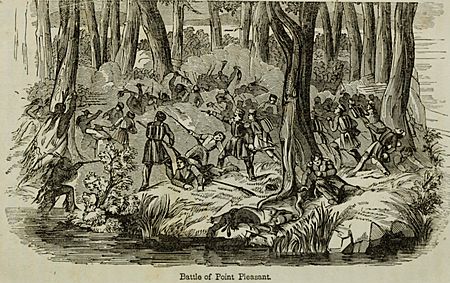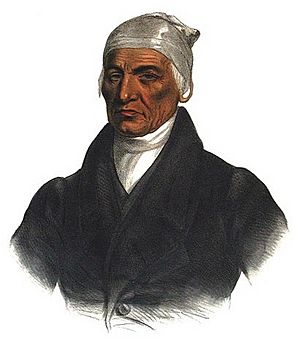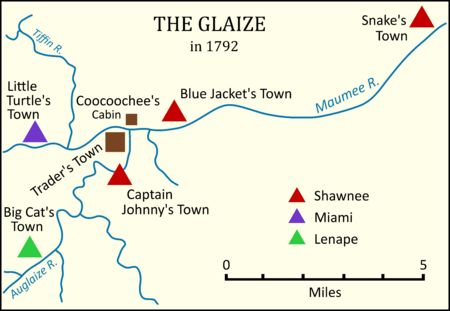Snake (Shawnee leader) facts for kids
Quick facts for kids
Peteusha
|
|
|---|---|
| Died | c. 1813 present-day Wapakoneta, Ohio
|
| Nationality | Shawnee |
| Other names |
|
| Years active | 1774–1812 |
| Known for | Military leader in the Ohio Country |
|
Shemanetoo
|
|
|---|---|
| Died | late 1830s present-day Kansas
|
| Nationality | Shawnee |
| Other names |
|
| Years active | 1781–1817 |
| Known for | Signatory of several treaties |
Snake was the English name for two important Shawnee leaders: Peteusha (who died around 1813) and Shemanetoo (who died in the 1830s). People often called them "Snake" or similar names like "Black Snake." This makes it hard to tell them apart in old records.
Sometimes, both "Snakes" signed letters or appeared together. This shows they were two different people. There might have been even more Shawnee leaders called "Snake." Because of this, it's tough for historians to fully understand their lives. Peteusha and Shemanetoo were likely brothers.
Peteusha: A Strong Shawnee Leader
Peteusha was the older and more famous Shawnee leader. His name was spelled in many ways, like Peteasua or Pataso. He first appears in history during a conflict called Dunmore's War in 1774.
Why Did Dunmore's War Start?
This war began because of the 1768 Treaty of Fort Stanwix. In this treaty, the Iroquois gave away land south of the Ohio River to the British. This land is now West Virginia and Kentucky. The problem was that the Shawnees used this land for hunting, but they were not asked about the treaty.
As settlers moved into the area, fights broke out between them and Native peoples. The Shawnees tried to get other Native groups to join them to protect their hunting grounds. But British officials stopped other groups from joining. This left the Shawnees with only about 300 warriors to fight against 2,300 British soldiers.
Peteusha's Role in Early Conflicts
During Dunmore's War, Peteusha lived in a place called Snake's Town. It was located on the Muskingum River in the Ohio Country. In August 1774, colonial soldiers attacked and destroyed several Native towns, including Snake's Town.
Later, another British army invaded. Cornstalk, a main Shawnee war chief, decided to attack one part of the army before they could join up. This led to the Battle of Point Pleasant on October 10. Peteusha was one of Cornstalk's war chiefs, along with Blue Jacket and Pukeshinwau. The Shawnees fought well at first, but when more colonial soldiers arrived, they had to retreat.

Fighting for Land in the Revolutionary War
Shawnee resistance continued during the American Revolutionary War (1775–1783). In the Ohio Country, this war was between American settlers and Native peoples. The Native groups got help from their British allies.
By 1779, Peteusha was known as one of the main Shawnee war chiefs. He became a key military leader at Wakatomika, a Shawnee town near present-day Zanesfield, Ohio. This town was a center for fighting against American expansion. In 1782, Peteusha led Shawnees to victory against Colonel William Crawford's army.
The Northwest Indian War and New Towns
After the Revolutionary War, the United States claimed the lands north of the Ohio River. Some Shawnee leaders wanted peace, but Peteusha and others at Wakatomika did not agree. They refused to accept that they had lost their Ohio lands.
Violence continued between Shawnees and settlers. A new war, the Northwest Indian War, began. After Americans destroyed Shawnee towns in 1786, Peteusha built a new town. This town was on the Maumee River, near modern Fort Wayne, Indiana. It was close to other Native towns, including Kekionga, the main town of the Miamis. The Miamis became important allies against American expansion.
Peteusha's Raids and Diplomacy
In 1787, the United States called the Native lands north of the Ohio River the Northwest Territory. Peteusha led about 100 Shawnees, Mingos, and Cherokees in raids against American settlers. They attacked settlers in Kentucky or those traveling on the Ohio River. Tecumseh, who later became a famous warrior, had his first success in one of these attacks in 1788.
These successful raids led the United States to send a military expedition in 1790. General Josiah Harmar led this army, but his men were defeated by warriors led by Blue Jacket and Little Turtle. Peteusha likely took part in these battles. Peteusha also traveled widely as a diplomat, working with the British and other Native groups.
After the Battle of Fallen Timbers
In 1792, Peteusha built another new town on the Auglaize River. This area was known as "The Glaize" and became the new headquarters for the Native alliance. In 1794, these towns were abandoned when a new American army arrived. This army, led by General Anthony Wayne, defeated the Native alliance at the Battle of Fallen Timbers on August 20, 1794.
Some Shawnee leaders decided to make peace. They signed the Treaty of Greenville in 1795, giving away what is now southern and eastern Ohio to the United States. Peteusha did not sign this treaty.
After the war, Peteusha settled in Wapakoneta. This was the new Shawnee capital. He supported efforts to help Shawnees live peacefully with their white neighbors. Later, a new movement began, led by Tenskwatawa, the Shawnee Prophet, and his brother Tecumseh. They wanted to reject American ways. Peteusha did not support this movement. He seems to have died around 1813.
Shemanetoo: A Treaty Signer
Shemanetoo was younger and less famous than Peteusha. He had a daughter named Nenexse, who married Black Hoof (Catecahassa). Black Hoof was a very important Shawnee chief.

Shemanetoo in the War of 1812
When the War of 1812 reached Ohio, most Shawnees wanted to stay neutral. But American leaders pressured them to choose a side. Black Hoof and another chief, Captain Lewis, decided to help the Americans.
In August 1813, Shemanetoo and Captain Lewis joined over 200 Shawnee and Lenape warriors. They went with American General William Henry Harrison to invade Upper Canada. They served as scouts and skirmishers. Shemanetoo and the Shawnees were present at the Battle of the Thames on October 5, 1813. This was where Tecumseh was killed. More Shawnees fought with Harrison's army at this battle than with Tecumseh.
Signing Treaties for Shawnee Land
After the war, the Americans wanted to gain the loyalty of Native groups. Shemanetoo signed the Treaty of Greenville (1814), where his name was written as "Shammonetho, or Snake." He also signed the Treaty of Spring Wells in 1815. This treaty confirmed that the Shawnees still owned the land given to them in the 1795 Treaty of Greenville. Shemanetoo signed this as "Shemenetoo, or big snake."
As more Americans moved into Ohio, there was pressure on the Shawnees to give up their land. In the 1817 Treaty of Fort Meigs, Shemanetoo and other Shawnee leaders gave up northwestern Ohio. In return, they received small reservations. Shemanetoo signed this treaty as "Shemenetu, or Big Snake."
This treaty created three small Shawnee reservations in Ohio: Wapakoneta, Lewistown, and Hog Creek. The United States Senate had concerns about this treaty. They wanted to make sure the U.S. government still controlled the land. So, a new agreement, the 1818 Treaty of St. Mary's, was made. This treaty made it clear that if Shawnees sold their land, they could only sell it to the U.S. government. Shemanetoo also signed this treaty.
Even with reservations, white settlers still used Shawnee lands. The U.S. government began a policy of Indian removal. This encouraged Native peoples to give up their lands and move west. Shemanetoo eventually moved west and died in present-day Kansas in the late 1830s.


